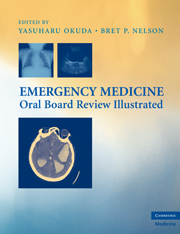Book contents
- Frontmatter
- Contents
- Contributors
- 1 How to Use This Book
- 2 EM Medical Decision Making
- 3 About the Oral Boards: The Approach and Practical Tips
- CASES
- Appendix A The Chest Pain Patient: Five Life-Threatening Causes and Critical Actions
- Appendix B The Confused Patient: Ten Most Common Causes and Critical Actions
- Appendix C The Poisoned Patient: Most Common Toxidromes and Treatments
- Appendix D The Trauma Patient: The Approach and Important Principles
- Appendix E Advanced Cardiac Life Support Review
- Appendix F Pediatric Pearls: High-Yield Facts from Fever to Drugs
- Appendix G Twenty Common Emergency Medicine Procedures: Indications, Contraindications, Technique, and Complications
- Appendix H Image Answer Key
- Index
- Plate section
Appendix D - The Trauma Patient: The Approach and Important Principles
Published online by Cambridge University Press: 04 August 2010
- Frontmatter
- Contents
- Contributors
- 1 How to Use This Book
- 2 EM Medical Decision Making
- 3 About the Oral Boards: The Approach and Practical Tips
- CASES
- Appendix A The Chest Pain Patient: Five Life-Threatening Causes and Critical Actions
- Appendix B The Confused Patient: Ten Most Common Causes and Critical Actions
- Appendix C The Poisoned Patient: Most Common Toxidromes and Treatments
- Appendix D The Trauma Patient: The Approach and Important Principles
- Appendix E Advanced Cardiac Life Support Review
- Appendix F Pediatric Pearls: High-Yield Facts from Fever to Drugs
- Appendix G Twenty Common Emergency Medicine Procedures: Indications, Contraindications, Technique, and Complications
- Appendix H Image Answer Key
- Index
- Plate section
Summary
Questions to ask for EVERY trauma victim:
“When I walk in to the room what do I see?”
“Is there any more information from EMS about the scene or mechanism?” – if the answer seems long or they have lists of the patient's medications or past medical history, ask them to stay and get back to them later.
ABCDE: “I would like to assess the patient's airway, breathing and circulation, have the patient exposed and placed on a monitor, have 2 large-bore IVs placed, and see the patient's vital signs.”
The initial assessment will drive the first BIG decisions:
Intubation: GCS <8, combative, airway protection, injury with likelihood of airway compromise later (neck or facial trauma). Use rapid sequence intubation (RSI) unless difficulty is predicted and then be prepared for surgical airway and consider awake or fiberoptic intubation. It is probably simplest to use etomidate, succinylcholine (or rocuronium), and consider lidocaine and fentanyl for head, injured patients for all RSI cases – deviation from the standard may cause unnecessary extra questions.
Tube thoracostomy: Decreased breath sounds on initial evaluation, asymmetrical chest movement (flail segment). Unless you are asked to describe the procedure, keep it simple.
Take other obvious steps – stanch arterial bleeding, assess the abdomen and pelvis, and wrap the pelvis if unstable.
For most patients you will want to start 2 L of crystalloid resuscitation at this point.
Order basic trauma labs and studies – CBC, chemistry, alcohol, coagulation studies, type and cross for two units, C spine (cross-table if high suspicion for injury, otherwise defer to CT scan), chest and pelvis x-ray.
- Type
- Chapter
- Information
- Emergency Medicine Oral Board Review Illustrated , pp. 497 - 498Publisher: Cambridge University PressPrint publication year: 2009



